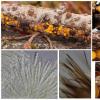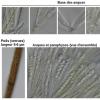
07-01-2026 17:29
 Marc Detollenaere
Marc Detollenaere
Dear Forum,On a barkless Populus I found some smal

10-11-2021 17:33
 Riet van Oosten
Riet van Oosten
Add-on topic http://www.ascofrance.com/forum/7059

07-01-2026 10:24
 Danny Newman
Danny Newman
Pezicula sp. on indet. hardwood Appalachian Highl

07-01-2026 10:05
 Danny Newman
Danny Newman
cf. Chaetospermum on XylariaCosby Campground, Grea

02-01-2026 17:43
MARICEL PATINOHi there, although I couldn't see the fruitbody, I

04-01-2026 17:45
 Stephen Martin Mifsud
Stephen Martin Mifsud
I was happy to find these orange asmocyetes which

03-01-2026 13:08
Niek SchrierHi all,We found groups of perithecia on a Lecanora
 Bonjour à tous,
Bonjour à tous,Je retrouve Ascofrance avec plaisir après de longs mois d'absence. Je voudrais partager avec vous la récolte d'un petit discomycète trouvé tout récemment sur des branches d'épicéas (rectification : sur branches de mélèze) tombées à terre (une coupe de bois a été effectuée l'an passé dans la zone prospectée). La zone est humide et la neige vient tout juste de fondre. La récolte a eu lieu dans les Alpes-Maritimes, le 10 mai, le long de la piste de l'ancienne vacherie du Devensé, à 1800 m d'altitude environ.
Description : je fournis une vue d'ensemble prise sur le terrain et deux macros. Les apothécies sont courtement stipitées et mesurent jusqu'à 6 mm de diamètre. La face extérieure est brune et finement velue. L'hyménium est jaune d'œuf ou jaune d'or, avec parfois quelques cercles concentriques. Les spécimens les plus jeunes sont cupulés, les plus âgés sont souvent pulvinés.
Microscopie : les spores sont lisses (en DIC et à fort grossissement), hyalines, ellipsoïdes, de 7,5-8,3-10 x 4-4,4-5,5 µm (Q = 1,5-1,9-2,1) dans l'eau (24 spores matures mesurées sur sporée). Les paraphyses contiennent des pigments jaunes peu denses. Les asques ne donnent aucune coloration dans le liquide de Lugol.
En l'état actuel je pense à quelque chose comme Lachnellula arida (W. Phillips) Dennis. Cette détermination vous semble-t-elle plausible ? Je serai très heureux d'avoir votre avis sur la question. Il me reste des échantillons pour effectuer d'autres observations si nécessaire. D'avance un grand merci pour votre aide !
Cordialement.
Hello everyone,
After being absent for a while, I am here again with great pleasure. Today I would like to show you a small discomycete recently found on spruce (this is wrong : please read larch instead of spruce) twigs fallen on the ground (there was forest work on this site last year). The area was wet and the snow has just melted. The exact location is in the Alpes-Maritimes along the track of the old farm of Devensé, circa 1800 m.
Please look at the given pictures and macros. Apothecia are shortly stipitate, up to 6 mm in diameter. The outer part is brown and finely hairy. The hymenium is yellow, sometimes with some visible concentric circles. The younger specimens are generally cup-shaped and the older ones are often pulvinated.
Microscopy: the spores are smooth (DIC illumination at high magnification), hyaline, ellipsoid, 7,5-8,3-10 x 4-4,4-5,5 µm (Q = 1,5-1,9-2,1) in water (24 mature spores, out of the asci). Paraphyses contain yellow pigments. The asci do not react to Lugol staining.
As far as I know, this species could be something like Lachnellula arida (W. Phillips) Dennis, but I would appreciate your comments on this determination. Does it sound good for you? I still have samples in the fridge for performing complementary observations if necessary. Thank your very much for your kind help.
Best regards.

Cela étant dit, je n'ai pas le sentiment que la branche présentée représente de l'épicéa... A vérifier.

Merci pour votre réponse rapide. Effectivement, ça ressemble à une branche de mélèze... je me suis laissé duper par la présence d'un grand nombre de branchages d'épicéas (seuls les épicéas, largement majoritaires, sont exploités par les forestiers sur le site). C'est un bois mêlé et, vérification faite sur l'échantillon prélevé, c'est bien du mélèze... bref, désolé pour la méprise.
Cordialement.

I agree, also with the substrate, the short buds appear characteristic of larch.
What you should uirgently look is the ascus base, whether with oru without croziers. Both exists in this species, maybe there exist two very close forms of L. arida.
When you look in my key you will see. I know only very few records from Europe.
Zotto
Here you can download (version May 2012)

Best regards.

I did the observations requested to help in the determination of this Lachnellula. Please find the pictures attached below. In summary, using your precious dichotomous key, I did the following reasoning :
- Brown hairs -> 2
- Spores ellipsoid -> 3
- Asci IKI- -> 4
- Spores 6.5-12 µm long -> 7
- Spores 3.3-5.5 µm wide, ellipsoid -> 8
- Hairs 4-7 µm (my data : 5-6 µm), deep brown -> 9
- Asci arising from simple septa (see pictures) without aseptate protuberances -> L. arida
Do you think it is ok ? My current feeling is that the differences between L. arida and L. flavovirens appear small to my inexperienced eyes. I see that the latter has darker and thicker hairs, but is it the main way to discriminate between these species ??
Thank you again for your help.

I wrote that arida has darker, thicker-walled hairs, but I am not sure how important this is. Spores are a little longer and narrower in my single specimen of flavovirens, and the asci are with croziers or protuberances, unlike yours. We cannot be sure that these features are also true for the type of flavovirens....
Lachnellula is a quite difficult genus, with much variation .
Zotto

Best regards.

I would actually be pleased to have a short look at the material, especially for the width of the hair wall, which I doubt a bit as a good character in my key. A small fragment of your specimen would be enough.
In the case you come to Somiedo you can give it to me also there.
Thanks
Zotto
Blaihofstr. 42
D-72074 Tübingen
Germany

Thank you.





 Lachnellula-Baral-2008-0002.doc
Lachnellula-Baral-2008-0002.doc